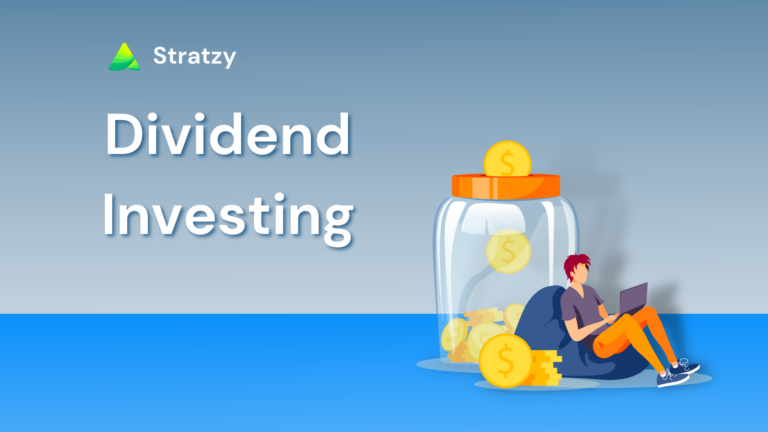DIVIDEND INVESTING

"Not every stock pays a dividend, but a steady, dependable dividend stream can provide nice ballast to a portfolio’s return."
What if I say you can enjoy both: the returns of the stock market and the benefit of low risk in FDs in a single investment? SHOCKED..!!
Welcome to the era of DIVIDEND INVESTING.
Before moving ahead, let’s understand some prerequisites need for understanding Dividend Investing.
Let’s first understand: What Are Dividend Stocks?
The companies that consistently distribute profits as dividends to their shareholders and have a tremendous track record are known as dividend stocks. Dividend-paying companies also have substantial amounts of cash, and therefore, are usually strong companies with good prospects for long-term performance.
Why buy Dividend Stocks? or What’s in it for you?
( or why do you even need to know about Dividend Stuff? )
- They’re significantly less risky than other stocks
- Dividends act as a passive source of Income
- Reinvest your dividends (Compounding effect)
- Value appreciation
- Helps fight inflation and is prone to market volatility
Okay, But What is Dividend Investing Strategy?
Dividend investing is simply a strategy of buying stocks that pay an income in the form of a dividend. This gives you a regular income stream from your investments, in addition to any growth in the market value of the stock.
Let’s understand this with an example:
For this, we consider the stock: Vedanta Ltd… Vedanta has a dividend yield of 20.1% as of July 2022 which can be considered to be an excellent yield.
So, the price of 1 share of Vedanta in August 2012 was Rs. 190. Suppose if you’d have bought 1000 shares which would’ve cost you Rs. 1,90,000 then you’d have received a dividend of Rs. 183/Share until July’22, dividend on 1000 shares totals to Rs. 1,83,000. So here you see your initial investment amount is not only safe but you’ve earned 96.2% just as a dividend apart from a capital appreciation of 34.2%. So, your amount of 1,90,000 invested 10 years ago would now amount to Rs. 4,37,000 (Approx.)
Getting Lucky with Dividend Investing:
There have been many cases where the dividend payout is more than the actual stock price. JAWS DROPPED..! Yes, you’ve read it correctly. Let’s check on some examples in the past:
Strides Pharma: This stock traded at around Rs. 100 in Jan 2010. In December 2013, the company declared a dividend of Rs. 500 which resulted in the stock price rallying to a high of Rs. 425 in December 2013. Not over yet, the company again declared a dividend of Rs. 105 in October 2014 which drove the investors crazy as also the price of shares. Within 5 years from 2010, the stock was trading at its all-time high levels of above Rs. 1300.
If you invested in 1000 shares in Jan 2010, which might have cost you around Rs. 1,00,000, it would have turned to Rs. 13,00,000 (return of 1200%) by the end of 2015. Also, you would’ve received a dividend of Rs. 620/share in the same holding period which would amount to Rs. 6,20,000.

Now you guys seem to be interested
Let’s check the Performance of High Dividend Yielding Stocks
For this study, we took a set of 31 stocks with good dividend yields and studied their performance over the past 10 years.
From August 2012, the Nifty 50 have given a return of 328% ( means Rs. 1,00,000 invested would turn to Rs. 3,28,000) which might leave your jaws dropping.
But wait for Dividend Stocks because they have given a return of 111.4% only through dividends i.e. you’re money will become more than 2 times in 10 years just through dividends. Apart from dividends the stocks, capital appreciation was 427% which gives a total return of 638.44% in 10 years ( which means Rs 1,00,000 invested would turn to Rs. 6,38,000)
Biggest Question:
How to Identify High Dividend-Yielding Stocks?
Identifying dividend stocks can be a tough task especially when you’re a new bee to the market or don’t have much time to devote. It might take you to invest your precious time turning pages of balance sheets, going through lots of research and backtracking of performance. Also, since dividends is not guaranteed, you need to keep yourself updated on the market and the company’s performance and what is expected in the future.
But Why worry when you have Stratzy by your side..!!
So, Stratzy has this amazing DIVIDEND DONS
Strategy. It is a basket of stocks with good dividend yields and a high probability of value appreciation. Also since it is not always the companies that might perform well so, Stratzy also provides the benefits of rebalancing wherein the stocks are rebalanced with new stocks to sustain your portfolio growth.
Different terminologies investors should know before moving ahead with investing in Dividend Stocks
- Dividend: It is a distribution of earnings, often quarterly, by a company to its shareholders in the form of cash or stock reinvestment.
- Dividend Payout Ratio: It is the ratio of the total amount of dividends paid out to shareholders relative to the net income of the company. ( Example: if the company earns a profit of 100 crores and distributes 60 crores to its shareholders as dividends, then the Dividend Payout ratio will be 60% )
- Dividend Yield: It is a financial ratio that shows how much a company pays out in dividends each year relative to the market price of the stock. ( Example: If a company pays out Rs. 20/ share as dividends and its share price is Rs. 120, then dividend yield will be (20/120)*100 = 16.67% )
Final Thoughts
Investors can go for Dividend Investing if their risk profile is low or would like to have a steady source of income. Dividend Stocks should be a must in your portfolio because it helps you fight inflation and acts as your portfolio’s defense army.
But on the other hand, high dividend stocks also represent that the company has peaked its growth potential and its possibilities to expand across other sector is limited.
So, Dividend Investing requires investors to be fully aware of not only the company but also its sectors and the sector’s & company’s future growth to get the maximum return.
